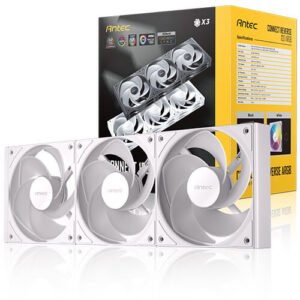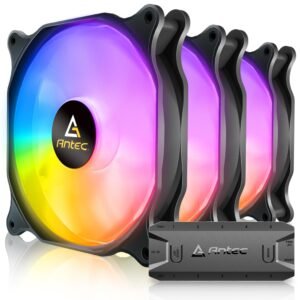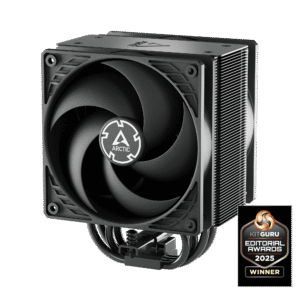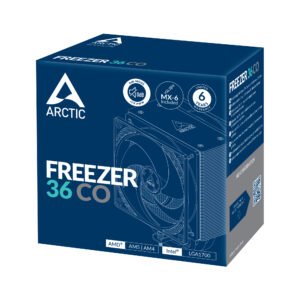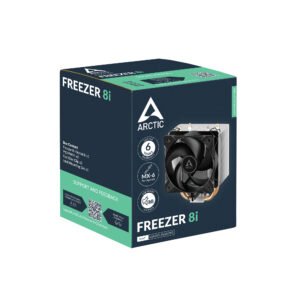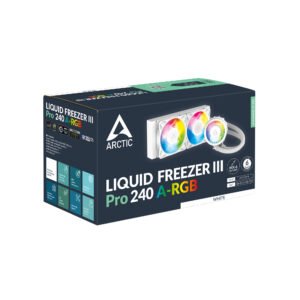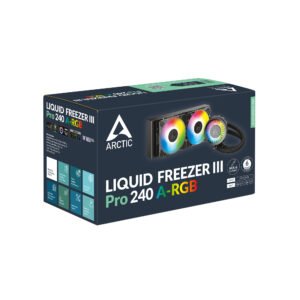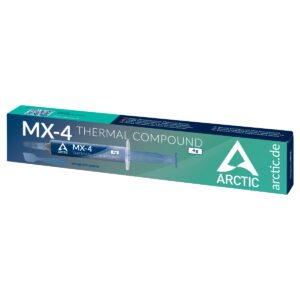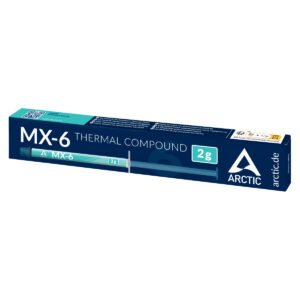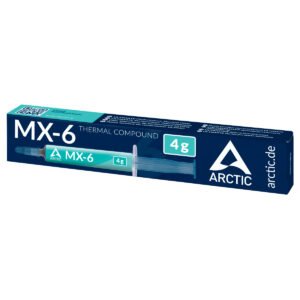No products in the cart.
Return To ShopNeed help? Call us:
+20 101 8107 004
ANTEC Connect 120 reverse ARGB 120 ARGB PWM FAN WHITE
1.300,00 EGP
Model Name C120R ARGB_3PK / C120R ARGB White_3PK Fan Type ARGB PWM Fan Dimensions 120*120*25 mm Bearing Type Hydraulic Bearing Fan Speed 800RPM± 10% –...
ANTEC STORM T3 ARGB 140MMX3 KIT
1.600,00 EGP
Product Dimensions 5.51″L x 1.18″W x 5.51″H (14 x 3 x 14 cm) Brand Antec Power Connector Type 4-Pin Voltage 12 Volts (DC) Wattage 2.5...
ARCTIC Freezer 36 (Black) Multi Compatible Tower CPU Cooler
1.850,00 EGPHigh-Class Finish with Aluminium Top Plate
With its push-pull configuration, the Freezer 36 not only impresses with its efficient cooling performance, but also with its design. The soldered ends of the heatpipes are concealed by the screwed aluminium cover, allowing it to blend seamlessly into any PC setup and highlight both performance and appearance.LGA1851 | LGA1700 Contact Frame
Intel's Independent Loading Mechanism (ILM) deforms the CPU by pressing it into the socket at two points with over 40 kg. This causes pressure in the PCB, the DIE and the solder layer between the DIE and IHS (Integrated Heat Spreader). With high thermal load, this can lead to long-term problems. The mounting frame from ARCTIC does not deform the CPU, reduces the mechanical load on the CPU massively, is quick and easy to install and allows the cooler to be screwed onto the CPU's backplate. As a result, mechanical stress on the mainboard and CPU is minimised, cooling performance remains consistent and installation is quick and uncomplicated.High-Quality Bearing
Thanks to a combination of alloy and lubricant developed in Germany, friction within the bearing is minimised and greater efficiency is achieved. In addition to preventing lubricant loss, wear on the pin and sleeve is also minimised. In this way, less heat is generated, less bearing noise is produced and the service life of the fan is significantly extended.ARCTIC Freezer 36 CO Multi Compatible Tower CPU Cooler for Continuous Operation
1.750,00 EGPHigh-Class Finish with Aluminium Top Plate
With its push-pull configuration, the Freezer 36 CO not only impresses with its efficient cooling performance, but also with its design. The soldered ends of the heatpipes are concealed by the screwed aluminium cover, allowing it to blend seamlessly into any PC setup and highlight both performance and appearance.LGA1851 | LGA1700 Contact Frame
Intel's Independent Loading Mechanism (ILM) deforms the CPU by pressing it into the socket at two points with over 40 kg. This causes pressure in the PCB, the DIE and the solder layer between the DIE and IHS (Integrated Heat Spreader). With high thermal load, this can lead to long-term problems. The mounting frame from ARCTIC does not deform the CPU, reduces the mechanical load on the CPU massively, is quick and easy to install and allows the cooler to be screwed onto the CPU's backplate. As a result, mechanical stress on the mainboard and CPU is minimised, cooling performance remains consistent and installation is quick and uncomplicated.Designed for Continuous Operation
Both fans of the Freezer 36 CO are each equipped with two japanese ball bearings. This makes these fans particularly durable and resistant to external forces such as heat, dust and vibrations. This variant is therefore the ideal choice for 24/7 operation.ARCTIC Freezer 8i Compact Intel CPU Cooler
1.100,00 EGPCompact Design
Thanks to its low height, the Freezer 8i is ideal for compact cases and offers maximum compatibility with high RAM modules and nearby components.For Intel Sockets LGA1851 and LGA1700
The scope of delivery only includes mounting material for Intel systems - this reduces packaging waste and saves unnecessary material.Efficient Cooling with Offset Heatpipes
The offset arrangement ensures optimal heat transfer from the base to the fins – for even heat distribution and improved cooling performance.ARCTIC Liquid Freezer III 420 A-RGB (White) Multi Compatible All-in-One CPU Water Cooler with A-RGB
7.500,00 EGPReady Out-of-the-Box - Easy Installation
The Liquid Freezer III is ready for immediate use thanks to its pre-installed radiator fans in push configuration. The fan cables are integrated into the jacket of the hoses so that only one cable needs to be connected to the motherboard. With the MX-6 thermal compound included in delivery, you have everything you need for quick and easy installation.Contact Frame for Intel LGA1700 and LGA1851
Intel's Independent Loading Mechanism (ILM) deforms the CPU by pressing it into the socket at two points with over 40 kg. This causes pressure in the PCB, the die and the solder layer between the die and IHS (Integrated Heat Spreader). With high thermal load, this can lead to long-term problems. The mounting frame from ARCTIC does not deform the CPU, reduces the mechanical load on the CPU massively, is quick and easy to install and allows the cooler to be screwed onto the CPU's backplate. As a result, mechanical stress on the mainboard and CPU is minimised, cooling performance remains consistent and installation is quick and uncomplicated.Integrated Cable Management
The fan cables are hidden within the sleeving. With the Liquid Freezer III, only the connectors from the pump head need to be connected to the motherboard—no additional cable routing required. No extra splitter cables are needed, which simplifies installation and improves the overall look.Addressable LEDs for all Requirements
ARCTIC uses standardised 3-pin cables instead of proprietary connectors. This not only ensures compatibility with most lighting systems for motherboards, cases, controllers and accessories, but also enables software-based control with the most common control programmes. The daisy-chain function also ensures that each LED can display an individual colour at any time, offering countless combination options for every preference.ARCTIC's partner SignalRGB offers a comprehensive solution for synchronisation and individual configuration of the illumination.ARCTIC Liquid Freezer III Pro 240 A-RGB (White) Multi Compatible All-in-One CPU Water Cooler with A-RGB
4.900,00 EGPIntegrated VRM Fan
PWM-controlled fan lowers the voltage regulator temperature, ensuring stable performance.Offset Mounting for Intel and AMD
Shifts the cold plate to the CPU hotspot for more efficient heat transfer.Intel Contact Frame
Optimized contact pressure distribution for longer CPU lifespan and improved heat dissipation.ARCTIC Liquid Freezer III Pro 240 A-RGB Multi Compatible All-in-One CPU Water Cooler with A-RGB
4.900,00 EGPIntegrated VRM Fan
PWM-controlled fan lowers the voltage regulator temperature, ensuring stable performance.Offset Mounting for Intel and AMD
Shifts the cold plate to the CPU hotspot for more efficient heat transfer.Intel Contact Frame
Optimized contact pressure distribution for longer CPU lifespan and improved heat dissipation.ARCTIC Liquid Freezer III Pro 240 Multi Compatible All-in-One CPU Water Cooler
4.500,00 EGPIntegrated VRM Fan
PWM-controlled fan lowers the voltage regulator temperature, ensuring stable performance.Offset Mounting for Intel and AMD
Shifts the cold plate to the CPU hotspot for more efficient heat transfer.Intel Contact Frame
Optimized contact pressure distribution for longer CPU lifespan and improved heat dissipation.ARCTIC MX-4 PREMIUM Performance Thermal Paste 4G
200,00 EGPOptimal Consistency for Every Application
Depending on personal preference and area of application, a thinner or thicker thermal compound may be preferred. Excellent non-drying and non-bleeding properties ensure constant long-term performance. With ARCTIC thermal pastes you will find the optimal viscosity for your application.Highest Thermal Conductivity
The surfaces of processor chips and cooler floors are covered with microscopic dents; ARCTIC‘s MX-4 thermal paste is composed of microparticles which fill these cavities. This leads to extremely high thermal conductivity, guaranteeing that heat is dissipated quickly and efficiently from the CPU or GPU. With its outstanding performance, the MX-4 is not only an excellent choice for overclockers and enthusiasts, but also for other applications that require thermal transmission. MX-4 proves without a doubt that great performance does not necessarily require a high price.ARCTIC MX-6 ULTIMATE Performance Thermal Paste 2G
250,00 EGP20% Better Performance
With its improved composition, the ARCTIC MX-6 has a measurably lower thermal resistance than the MX-4. We measured the absolute thermal resistance of both pastes on our lab-testing machine, which is much more accurate than a CPU. Two factors are mainly relevant:- Conductivity
- Minimum Bond Line thickness
A lower thermal resistance of the paste leads to a lower temperature difference between CPU and cooler.
ARCTIC MX-6 ULTIMATE Performance Thermal Paste 4G
300,00 EGP20% Better Performance
With its improved composition, the ARCTIC MX-6 has a measurably lower thermal resistance than the MX-4. We measured the absolute thermal resistance of both pastes on our lab-testing machine, which is much more accurate than a CPU. Two factors are mainly relevant:- Conductivity
- Minimum Bond Line thickness
A lower thermal resistance of the paste leads to a lower temperature difference between CPU and cooler.
All Categories
Sorry, we couldn't find what you're looking for
Fliter by price
Product Status
Brands
Sorry, we couldn't find what you're looking for


